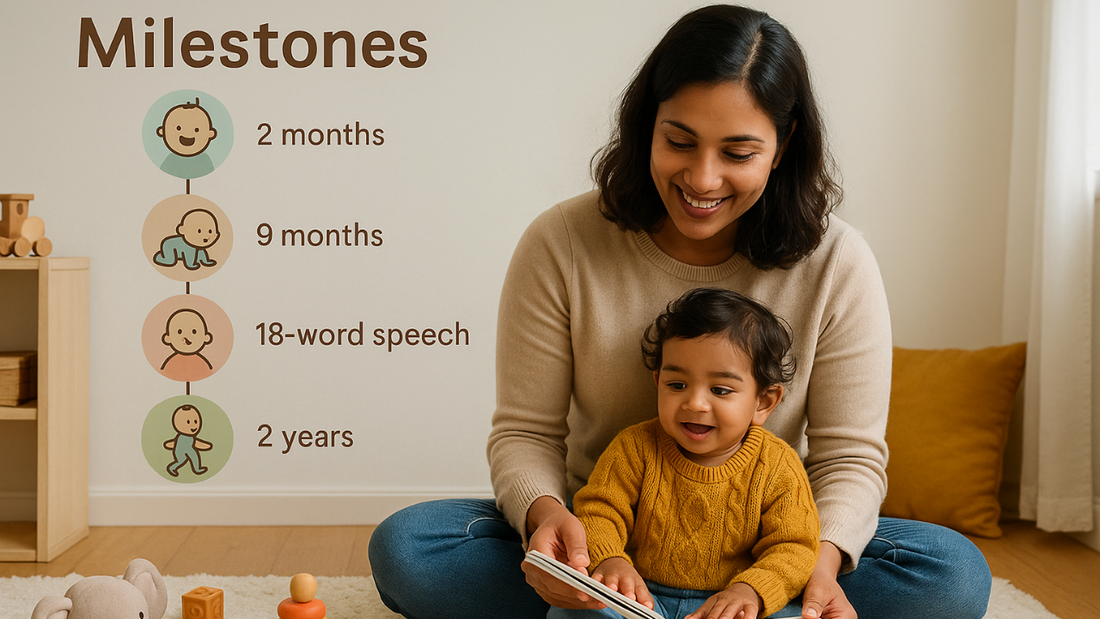
Age-Based Guide for Keeping Track of Growth (Based on Research)
LiLLBUDUnderstanding how kids usually grow can really help you support their development, celebrate their achievements, and spot when they might need extra help. Every child is unique, but researchers have noticed some common trends in motor skills, speech, and social abilities. Here’s a breakdown by age with milestones based on evidence and tips to encourage their growth.
Birth to 6 Months: Foundations of Sensing & Communication
Research-backed Milestones:
- Recognizing things with your senses and smiling at people: Babies can tell who their caregivers are by their voices and faces. Most babies start to smile socially when they see people they know within the first two months.
- At about 3 to 4 months, babies start to coo and babble. They make simple vowel and consonant sounds. They babble in more ways by the time they are 4 to 6 months old. This helps with oral motor control, which is important for speech later on. NIDCD
- Motor skills: During tummy time, babies start to lift their heads, follow moving things with their eyes, and reach for and grab things. Some babies might be able to roll over by the time they are 5 or 6 months old.
How to Help:
- Give them a lot of safe floor space and tummy time to reach and roll.
- Talk to the baby, sing to them, and make faces to keep them interested. Repetition and responding to others help the brain circuits. These are responsible for language and social skills.
- Keep screen time to a minimum; studies suggest that babies learn better from live interactions with people.
6–12 Months: Exploration & Early Words
Research-backed Milestones:
- Sitting, crawling, and pulling yourself up: By the time they are 6 to 8 months old, many babies can sit up on their own and start to crawl or move around.
- Gestures and name recognition: Babies begin to respond to their name and make gestures like pointing and waving.
- First words and early understanding: Some kids start saying simple words like "mama" or "dada." Research shows that by the age of 3, kids are around 50% understandable when they speak single words. Their clarity improves with longer phrases.
How to Help:
- Read picture books, point to things in the pictures, and say their names.
- Use simple words and gestures every day.
- Play games like peek-a-boo or hide and seek to help kids learn about object permanence and anticipation.
1–2 Years: Language Explosion & Independence
Research-backed Milestones:
- Vocabulary growth: By 18-24 months, many kids have a vocabulary of over 50 words . They start putting together two-word phrases. Both Hopkins Medicine and NIDCD highlight a notable increase in expressive vocabulary during this time. (Johns Hopkins Medicine)
- Following simple directions and understanding more than they can say: Comprehension usually comes before the ability to express oneself. At this age, kids usually know a lot more words than they can say.
How to Help:
- Talk to your child all the time, even if they don't respond right away. For example, say things like "We are washing our hands" or "It's time to eat."
- Ask them questions like "Do you want an apple or a pear?" to help them make decisions and use language.
- Studies show that too much screen time can make you less likely to hear conversational words. So limit it and make sure that interactions are rich and responsive. (The Guardian)
2–3 Years: Expanding Speech & Social Skills
Research-backed Milestones:
- Sentence formation: Kids start putting together 2–3-word phrases. This helps them expand their ideas.
- Better intelligibility: Growth curves show that intelligibility for both single-word and multi-word speech steadily gets better. During this age range, there is a lot of variation. (PubMed)
- Motor skills and emotional expression: Kids usually run, climb, and play pretend games, and they also show pride, frustration, and start sharing.
How to Help:
- Encourage pretend or symbolic play (like pretending to cook or play house), which helps kids learn language, make friends, and think.
- Read stories together and ask questions that don't have a clear answer, like "What do you think happens next?"
- Model rich speech and add to what they say, like, "You said 'dog-run,' yes, the dog is running fast!"
3–5 Years: Confidence, Imagination & Refinement
Research-backed Milestones:
- How clear and understandable speech is: By the time they are 4 or 5 years old, many kids can understand 75–90% of both single words and multi-word speech. Research indicates that multi-word intelligibility frequently exceeds single-word intelligibility by approximately four years of age. (ASHA Publications)
- Use of plurals, past tense markers, and more complicated vocabulary in sentences and grammar. Being able to tell colors, shapes, and numbers apart.
- Cooperative play, role-playing, knowing the rules, and being able to feel what others feel are all social skills.
How to Help:
- Tell stories, encourage drawing, and play pretend.
- Even if they aren't perfect, praise people who try to speak in complicated ways.
- Give kids a lot of chances to interact with other kids and adults.
When to Seek Guidance
- If there are no gestures, babbling, or sounds by the time the child is 12 months old.
- If vocabulary is very limited (well below peers) at 18 to 24 months.
- If intelligibility is very low, for example, children should be understood by familiar people most of the time at age 3.
- If there are worries about hearing, motor skills, or socializing. Early intervention frequently leads to significantly enhanced outcomes.
Milestones are not deadlines; they are averages. Research shows that speech intelligibility, vocabulary growth, motor skills, and social/emotional behaviors follow patterns that are easy to see, but there is a lot of variation. What matters most is regular, responsive interaction, a lot of play, telling stories, and a place that is safe and welcoming.

